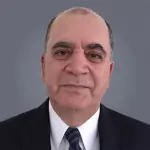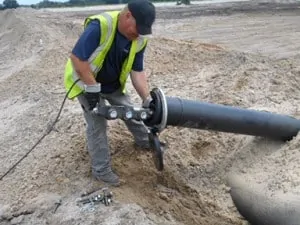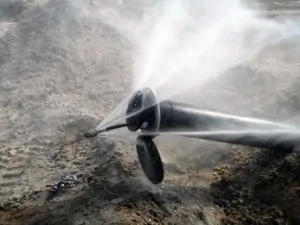

It is a general misconception that leachate seeps stop or disappear when slopes receive the final cover. In fact, it is only true if the source of leachate is located directly below the cover, but in most cases, the leachate originates from another location. Continuing seeps eventually reach the bottom of the slope, where two scenarios can happen depending on how the final cover geomembrane is secured at the landfill’s perimeter.
In the first scenario, where the geomembrane is anchored in an anchor trench, liquids will gradually flow underneath the cover geomembrane in the anchor trench and enter the perimeter berm structure. Leachate entering the berm structure softens the berm’s structural fill adversely impacting its shear strength. Additionally, leachate gradually seeps through the berm structure and enters natural formations below the berm and possibly into the groundwater. The operator is alerted when monitoring shows a localized structural failure or a groundwater impact in a nearby groundwater monitoring well.
In the second scenario, where the final cover geomembrane is welded to the bottom lining system geomembrane, leachate seeping out of the slope reaching the toe of the slope accumulates at the toe because it has nowhere to go. Accumulation of leachate behind the final cover geomembrane forces water to gradually move laterally along the landfill perimeter berm behind the final cover geomembrane damaging a larger area behind the final cover. Vertically, more of the area above the toe of the slope becomes engaged by the accumulating leachate. The two obvious consequences are the softening of the soil layer below the final cover geomembrane at the toe of the slope and the water-bedding effect of the area near the toe of the slope.
In the first scenario, the operator has to handle a non-compliance issue, either a failure in the slope or impacts to groundwater. In the second case, the leachate remains contained, but the operator has to address the issue by opening the final cover and removing leachate accumulated behind the final cover geomembrane. The geomembrane opening is closed, and final cover soils are restored after liquids are removed. Both are costly and complicated solutions. Moreover, the problem does not end after completion of the repair because the source of leachate seep is not eliminated.
Landfill operators can require their engineers to design a leachate toe drain system located at the toe of the slope and connected to the leachate collection system at the bottom of the landfill before the final cover geomembrane is installed. The leachate toe drain system is the only way to collect and route leachate to a location at the bottom of the landfill constructed for removal of leachate.
If you are closing a portion of your landfill slope and you find no leachate toe drain system in the construction plans, you can ask for a system to be added to the design plans before the commencement of the construction project.
SCS has significant experience with various types of leachate toe drain system constructed at different locations under various conditions. If you like to know more about the design of leachate toe drain systems or if you are looking for an experienced engineer for the design of your next final cover contact SCS.
Author: Dr. Ali Khatami
By Ali Khatami, Ph.D, P.E., SCS Engineers National Expert
Leachate seeping out of a landfill slope can be a major issue during the active life of a landfill, and waste operators undertake significant efforts to control and manage it. Uncontrolled seeps can cause soil erosion on the slope, odor issues, and unpleasant scenery on the landfill slope which is visible to adjacent public roads or properties. Leachate can also travel beyond the liner boundaries into perimeter ditches.
Leachate also can seep below the final cover, and that causes a different set of problems. Leachate seeps below final landfill covers are rarely discussed because of the general consensus that they become inactive after construction of the final cover system. That may be true under certain conditions, but very often, leachate seeps remain active as long as the source of water remains active and continues discharging through the seep locations. Leachate seeps below final covers can potentially:
If the final cover geomembrane is not welded to the bottom liner geomembrane, leachate seeping to the toe of the slope can reach the landfill perimeter ditch and contaminate the surface water, or it can percolate into the ground and cause ground water contamination that may be detected in nearby groundwater monitoring wells. Leachate seep also may enter the perimeter berm structure and saturate the berm to the point that the stability of the landfill slope becomes a concern.
If the final cover geomembrane is welded to the bottom liner geomembrane, the only way to address the accumulation of leachate under the cover at the toe of the slope is to open the geomembrane, remove the leachate, and close the geomembrane again. However, this process does not solve the seep problem, which will continue to recur.
SCS has designed various leachate toe drain systems to collect and dispose of leachate that flows below the final cover geomembrane. Leachate toe drains have become a standard feature in the final cover designs for some of our clients who have experienced the benefits of the system.
If you have leachate seep issues at your landfill, please contact SCS. We can develop a design specific to your landfill and the conditions at your facility. We also provide construction recommendations and a preliminary cost estimate for implementation of the system. SCS has extensive experience with the permitting of these systems; we prepare modification applications for permitting purposes and obtain approval from the state regulatory agency. SCS can also prepare the construction plans. We also offer design-build options, employing our SCS Field Services Construction group to construct the system, which often can be a cost-effective way to implement your system.

The benefits of implementing these cleaning recommendations for leachate collection pipes will help keep the pipes clean and fully functioning; helping landfill operators prevent the potentially serious complications of clogged pipes and immovable leachate.
By Dr. Ali Khatami, P.E., SCS Engineers
Some states require that leachate collection pipes be cleaned with high-pressure jets on a regular basis (for example, every ten years or even more frequently); however, the rules don’t clarify or set forth the specific conditions under which the jet cleaning should be performed. Some landfills have undertaken jet cleaning while the pipes are partially or fully submerged in leachate above the liner. Unfortunately, jetting under water may drastically reduce the effectiveness of the pressurized jet, resulting in a pipe that is not cleaned properly. This is even more important when the jetting is intended to remove biological growth on the pipe walls and in the perforation openings.

In addition, many states do not require videotaping the pipe after jetting. Videotaping is the best way to verify that the pipe was cleaned successfully. If the leachate collection pipes are not properly cleaned, then over a period of 20 years or so, they can be adversely impacted by severe biological growth and buildup in the pipe perforations to the point that liquid can no longer enter the pipe.
Another shortcoming is that the rules do not specifically require that the riser pipes (where the submersible pumps are located) be cleaned or videotaped. Therefore, due to the added costs, some landfill operators may not clean the riser pipes as part of the required cleaning events, or they may delay such cleanings for an extended period. This can prevent leachate from flowing into the riser with the direct and serious consequence that leachate cannot be removed from the sump.

Another issue to consider is that pressurized jet cleaning procedures do not necessarily push the solids that separate from the pipe wall out of the pipe inlet opening through which the cleaning nozzle entered the pipe. As a result, these solids flow out of the pipe and into the gravel bedding on the outside of the pipe, and can potentially clog the void within the gravel pack around the pipe or in the sump. Clogging the sump gravel can mean reduced flow capacity from the leachate collection pipe to the riser pipe and the submersible pumps.
To resolve these issues, SCS recommends the following:
The benefits of implementing these recommendations will help keep the pipes clean and fully functioning. These suggestions help prevent potentially serious complications that the landfill operator may have to address if the pipes are clogged and leachate cannot be removed.
Questions? Contact Ali Khatami, PhD, PE, LEP, CGC, is a Project Director and a Vice President of SCS Engineers. He is also our National Expert for Landfill Design and Construction Quality Assurance. He has nearly 40 years of research and professional experience in mechanical, structural, and civil engineering. Dr. Khatami has acquired extensive experience and knowledge in the areas of geology, hydrogeology, hydrology, hydraulics, construction methods, material science, construction quality assurance (CQA), and stability of earth systems. Dr. Khatami has applied this experience in the siting of numerous landfills and the remediation of hazardous waste contaminated sites.